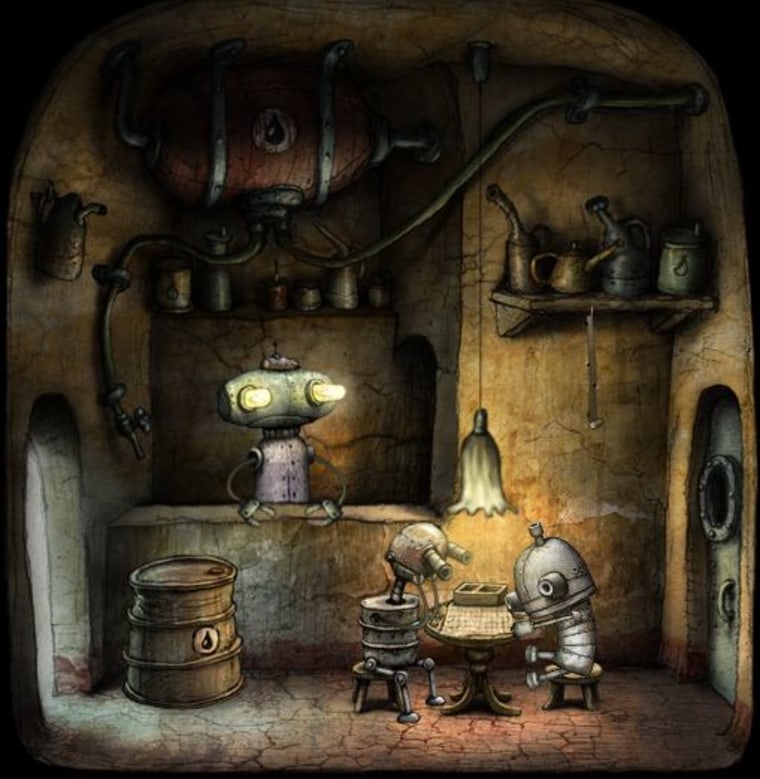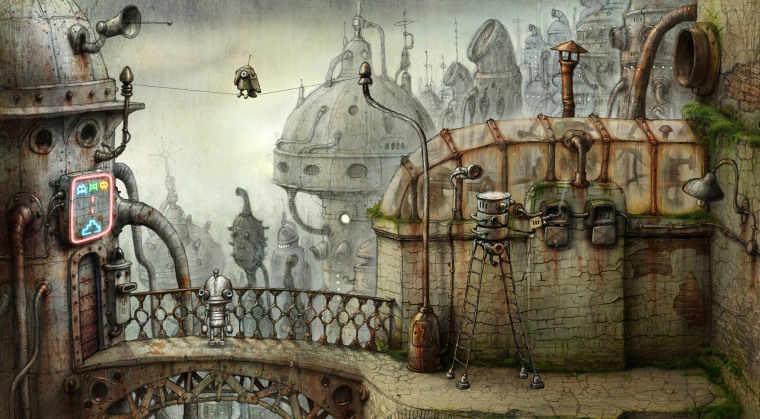There are some video games that you’re going to hear a lot about in the coming months — “Borderlands,” “Modern Warfare 2,” “Assassin’s Creed II,” “New Super Mario Bros.,” “Bioshock 2” and “MAG,” … just to name a few.
You’ll see these games ballyhooed on billboards, touted in TV commercials and emblazoned across one banner ad after another as legions of marketing pros fueled by piles of money work hard to keep them in the forefront of your brain.
After all, the winter months are the go-go-GO time of year for the game industry — a time when just about every publisher on the planet is pushing the products they’ve pinned their highest hopes on while hoping like the dickens that consumers will pluck them up en masse as the gift-giving/cash-cowing holidaze kick in.
The lingering months of 2009 and early 2010 are so jam-packed with top-tier game launches it's hard to keep track of what’s arriving when. This week alone saw the debut of two of the season’s heaviest hitters: Sony’s totally awesome PS3-pusher “Uncharted 2: Among Thieves,” not to mention the totally-rockin’ Jack Black vehicle “Brutal Legend.”
But there’s another game that launched this week — today in fact — a game that you likely haven’t heard of. It’s called “Machinarium.” And while you won’t see it ballyhooed on billboards or touted on TV commercials or emblazoned across one banner ad after another, it is just as totally awesome as those you will.

Created by seven guys in the Czech Republic working for free and using their savings to do so, “Machinarium” is an epic, elegant adventure game about robots and love and determination. It is a visual wonder filled with artful puzzles and a delightful sense of humor. It is fun. It is smart. It is nothing short of a gaming and artistic masterpiece — one that took the tiny team at Amanita Design three years to make.
And the marketing budget to promote this masterpiece? A mere $1,000.
All of this makes “Machinarium” a fine example of something game fans would do well to remember in the next few months: Sometimes it’s not the biggest games that end up making the biggest impression.
Take last year for example. Two of 2008’s most awe-inspiring-est and award-winning-est games seemed to come out of nowhere — “Braid” and “World of Goo.” These two independent titles were created by teams so small you could fit the whole lot of them into a canoe without sinking it. And still, both games ended up on every Best Game of the Year list that mattered.
Quirky, intelligent, unique — these sleeper hits were a welcome wakeup call.
The little games that could
And if all is right with the world, “Machinarium” ($20, available for PC and Mac) will be greeted with the same enthusiasm that “Braid” and “World of Goo” were greeted with — that is, it will be embraced not just by indie connoisseurs predisposed to appreciating these interactive underdogs, but by the game-playing masses at large.
But as Jonathan Blow, the game designer behind “Braid,” points out: Mainstream success is an elusive thing. “A lot of that is just unpredictable, and it doesn’t necessarily mean much about the inherent qualities of a game,” he said in a recent e-mail interview.
Meanwhile, this is an especially difficult time of year for indie games to get noticed, he says. The online gaming news sites — which smaller projects rely on for spreading the word — are often busy just trying to keep up with the onslaught of big-name titles.
“It is very hard to be heard above the noise,” Blow says.
But it can be done. “World of Goo,” which launched one year ago this week, managed to be heard loud and clear. And Kyle Gabler, one of the two people who created the game, says they didn’t spend a dime on advertising.
Instead, Gabler says, “It’s really important that indie developers aren’t shy about promoting themselves.” You have to create a website and “update it constantly,” he says. You have to enter festivals and call reporters. And “start promoting early,” he urges those shooting for “World of Goo”-style success. “Two years ahead of launch is not too early.”
Ultimately though, Gabler says, if developers are hoping to have that breakout indie hit, “The game matters. The game has to actually offer something new to the gaming world. Nobody is going to talk about another first-persons shooter with role-playing elements no matter how much effort is put into promotion.”
And that’s what makes these sleeper hits so sublime. The small projects coming from out of the blue offer something the big games often can’t — they offer something unexpected.
Jakub Dvorsky, the game designer masterminding “Machinarium” and the creator of beloved indie hits “Samorost” and “Samorost 2,” says he realizes that now is a difficult time of year to get a game like "Machinarium" noticed.
“We are releasing it now because we just finished it — it’s that simple,” he says. “Of course, it’s very crowded time of the year, but I hope it won’t get lost because it’s very different from most of the current 3-D games.”
True enough. Among the flood of holiday games, you won’t find anything like “Machinarium.”
Oh sure, it is a point-and-click adventure game — a well-traveled genre. But “Machinarium” is an adventure game done in such astounding and imaginative detail that it now sits at the pinnacle of the genre — a pinnacle that it has elevated to all new heights.

Though players are greeted with a somewhat bleak, industrial world populated by robots, the game is filled with so much heart, humor and wit it absolutely hums with life. Here players control a lovable robo-hero who chugs along with sprightly determination, outsmarting the mindless automatons and mechanical thugs who would keep him from the girl-bot he adores.
“To create the final look of the game was quite a long process,” Dvorsky says. “We felt we needed something warm with a visible human touch in it to create a contrast to that robotic world, so we came up with idea of hand-drawn backgrounds which were scanned and finished in computer. Also the animations are mostly hand-animated frame by frame.”
Certainly it’s the art work that is most immediately arresting — landscapes of rusted nuts, bolts and steel, of wayward steam pipes and wonky satellite dishes, all of it intricate and alive in its metal decay. But it’s not just the game’s pretty pictures that enchant — it’s “Machinarium’s” elegant, entrancing music, so perfect and so subtle. And it’s the game’s puzzles — inspired, comical and gleefully challenging.
The attention to detail found at every turn is nothing short of awe inspiring. “Machinarium” is the kind of game I was still playing long after the evening’s play time should have been over. It’s the kind of game I’d hate to see lost in the holiday shuffle.
The ones to watch for
“Machinarium” isn’t the only game that deserves not to get lost in the crush. I asked Dvorsky, Blow and Gabler which sleeper hits they saw lurking on the near horizon. Here’s just a few of the games they say shouldn’t be missed:
“” (Wii/PC): Launching in March 2010, this freaky, fast-paced platfomer looks to be one bloody fun game for WiiWare and PC. “Super Meat Boy” follows the exploits of a hunk of meat (Meat Boy himself) as he attempts to traverse a world that wants to cut him and make him bleed. Created by indie supa-stars Edmund McMillen and Tommy Refenes, the game features characters named Dr. Fetus and Band-Aid Girl and thus promises to be full of all kinds of jacked up hilarity and hardcore gaming. Check out the earlier Flash version of the game here.
“” (Wii): Designed by Nicklas “Nifflas” Nygren (the man behind famed beloved indie game “Knytt Stories”), this intriguing 2-D ball-rolling game has all the signs of a sleeper hit in the making. It’s unusual, elegant and comes with plenty of advance accolades. It was nominated for the Excellence in Design and for the Seumas McNally Grand Prize at the Independent Games Festival earlier this year.
“” (PC): This flower-powered strategy game takes space exploration to epic organic levels. Available on Oct. 20, “Eufloria” makes space combat look downright pretty. You won’t know whether you want to play it or hang it on your wall.
“” (PC): As Blow says on his Web site: "Osmos" starts with an idea that several games have done before: You’re a cell and you eat guys that are smaller than you in order to get bigger. But what makes this game stand out, he says, is "the way it adheres to the nature and feel of physics in space." It then explores these ideas and ventures into new territory. “The result is not merely a satisfying game,” Blow says. “It rings with that faint and distant sound of truth.”
“ (PC): In this awesome adrenalin-rush-of-a-recently-launched game, you toss yourself off the tops of buildings, watching the world rush by as you rush ground-ward, performing stunts, thrilling spectators, causing mayhem and earning points as you go. But don't forget: Gravity, she can be a harsh mistress.
A few more forthcoming games to keep your eyes on:“Cave Story,” “The Misadventures of PB Winterbottom,” “LostWinds: Winter of the Melodias,” and “.”
Winda Benedetti may be corporate on the outside, but she's nothing but indie on the inside ... or so she claims when .
